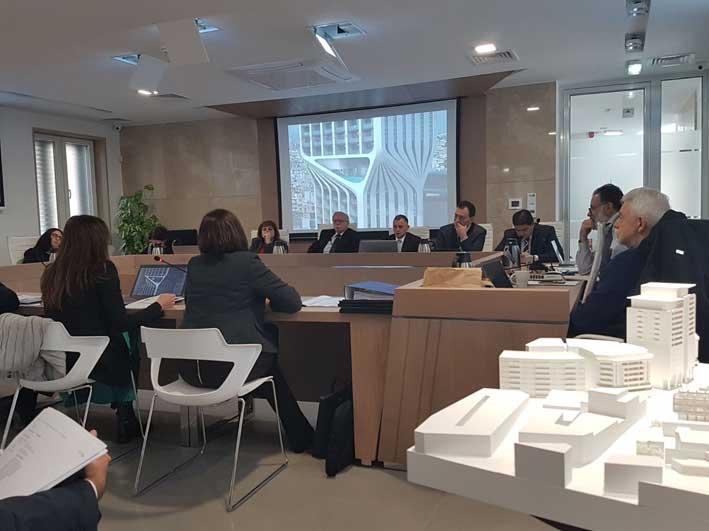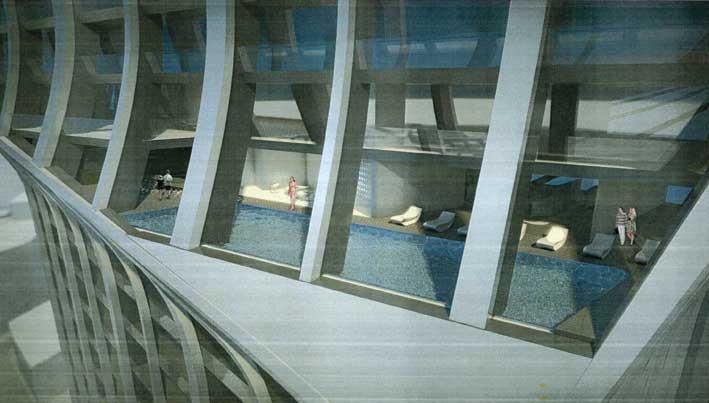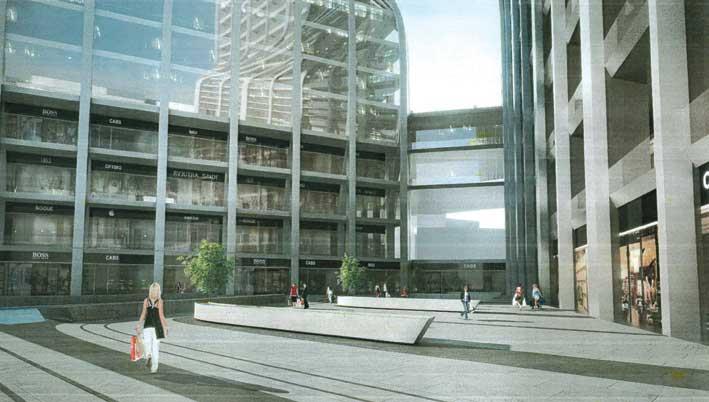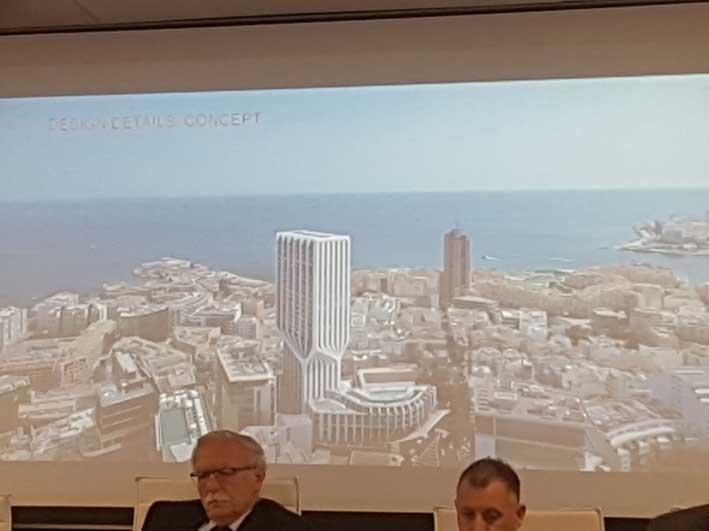The Planning Authority today approved plans to “amend” the Mercury House site, which will see a 31-storey tower built in the Paceville area.
The development will now include 275 residential apartments, and 48 hotel rooms. The design was handled by the Zaha Hadid architecture firm.
Gozitan Developer Joe Portelli had formally submitted this new application despite the Paceville Masterplan being on hold. This site was one proposed development that caused controversy during the masterplan debate period.
The Malta Independent has written extensively in the past about this particular development, and had broken the news of the 40-storey tower plans, which have now been reduced to 31.
(In pictures below, slide over the photo to get a view of how the situation looks like now and what it will look like with the towers)
The site has an area of circa 7,400sq.m of land within the development zone of Paceville. The site includes a scheduled monument, and has been earmarked for development since a development brief back in 2005, which had limited the building height to 15 storeys. An application had been approved in 2012 and gave permission for two (one 18 and the other 19-storey) adjacent office towers.
According to the Planning Authority’s website, the application deals with the “redesign of the iconic building concept to induce an elegant and contemporary architectural statement. The application also highlights the restoration of Mercury House, and the introduction of a new access to the underground ‘cold war vaults’.

The case officer’s report read that “while the site is currently being excavated, a change in the project redevelopment is being proposed through this application to construct underground parking, a new pavilion to the north of Mercury House, the restoration of Mercury House to be re-developed and extended as a 5 storey podium hotel building to the proposed 31 storey tower (118m) of serviced residential apartments and screening buildings for food and retail spaces around the public areas to screen the GO exchange building. The proposed development includes 48 hotel rooms, 275 serviced apartments, circa 3,300sqm of retail space and a multipurpose hall having an area of circa 830sqm.”
The tower is conceptualised as two stacked volumes with the upper part rotated in plan from the lower part. This results in a twist transitioning between floor levels 10 and 12. Both lower and upper blocks contain apartments, while the twist accommodates communal areas and amenities, including a pool over the proposed piazza next to Mercury House.
The report notes that there will be 4,259 sqm of open space.

“The design statement describes that the proposed development gives prominence to Mercury House as a prime heritage asset and a distinctive focal point, becoming the access point to both residential and hotel lobby areas. Public open spaces are proposed around Mercury House to provide visual and pedestrian permeability to streets neighbouring the site and a central piazza is proposed to provide the focal public space.”
There were a number of objectors to the application, including FIMbank p.l.c, Din l-Art Helwa and St. George's Park Co. Ltd.
Din l-Art Helwa said that whilst appreciating the great improvement in quality and design of the tall building from the previous approved structure, the proposal is out of scale with the context. Din l-Art Helwa sees no justification for an increase in height from 17 floors to 31 floors.”
St George's Park Co. Ltd questioned why the case was recommended for approval in the first place. They questioned that the 2005 Development Brief for the site was ignored.

The case officer recommended that the case be approved, and that €50,000 be sent into the Artistic Fund.
The applicant’s representatives argued that the site already has a permit for a tower, and while this proposal increases the height, the public space also increased. They said that the provision of parking (417 underground spaces), is more than what is required as per policy. They also believe the traffic impact will be reduced as people can opt to use public transport to their site.
Comments by the public
Swieqi Mayor Noel Muscat spoke during the hearing. “From the social side, this project, plus other projects in the pipeline will affect Swieqi considerably. With regards to the Traffic Impact Assessment, I cannot understand how this and others will not affect human and vehicular traffic, especially when one considers many go to that locality through the Regional Road. St George’s road is jam packed. Buses passing there cause havoc. The pavements in that area are very narrow. I ask the authorities to consider this, to carry out civil works to help people. “
Another person spoke of the traffic impact. He asked when the Planning Authority will stop fooling themselves that every residence only has one car, and that there are at least two per residence.
A third objector highlighted the 2005 development brief. He said that the brief sets out a piazza to be reserved as part of the overall site development, but despite that the authority has issued a number of permits on the site where this piazza was meant to be placed.
A representative of the applicant highlighted that appeals on the past permits on this basis were rejected. He argued that current policies cannot be ignored. “We are talking abut a 13-year-old brief. There was an evolution on the whole area and this application respects that.”

The St Julian’s Mayor Guido Dalli said they were not against a Master Plan, but were against the way it was presented.
ERA Chairman Victor Axiak said the EIA is not capable of taking cumulative effects with projects not yet considered, meaning that the EIA is not necessarily the best tool for considerations in general. He spoke of the need of a master plan, and as such without one, the PA is looking at things on a case by case basis.
PN MP Ryan Callus also spoke of the importance of a master plan, and the importance for it to continue being worked on. PL MP Alex Muscat agreed on the importance of a master plan.

Master plan tender at the department of contracts
A small debate about the master plan then occurred. PA CEO Johann Buttigieg said that a tender for the Paceville masterplan has been drafted, and was ready last November. It is currently being looked over by the department of contracts he said, and that the tender has not been issued. He mentioned additional safeguards, and that there can be no conflict of interest with whoever wins the tender.
The St Julian’s mayor and the NGO representative voted against. The chairman also voted against to strengthen the argument for the need of a master plan for the area. 10 members however voted in favour of the project.
An argument broke out over the need for a planning gain, with some board members calling for the inclusion of one, while others arguing otherwise. The applicant mentioned that the road and pavement between Mercury and Pendergardens is already going to be done up, which was one of the St Julian’s Mayor’s main concern areas. Mayor Dalli however mentioned that more still needs to be taken into consideration.
Buttigieg gave a few reasons as to why no planning gain was included, including that the development did not increase the floorspace from the accepted application, mentioning that there are a number of substantial obligations which will cost a significant amount of money as per the original application.
A vote was taken over the imposition of a €250,000 planning gain, however was turned down, with 5 members voting in favour and 8 against.
PD statement
The Partit Demokratiku condemned the Planning Authority's decision
The PD mentioned that there is a Private Member's Bill to discuss a National Masterplan. "Both PN and PL have not addressed it in the House Business Committee, so it cannot yet be included in the Parliamentary Agenda. One wonders why."
That National Masterplan was meant to avoid piecemeal haphazard development lacking supporting infrastructure, the PD said.
Partit Demokratiku asks whether the Planning Authority is simply there to rubber stamp any major development by big business?
"Does the PA understand the meaning of the word 'planning'? If it does, why has approval been given to this development before any Paceville Masterplan has been realised? No matter who the architects are, does the PA believe the visual impact is in keeping with the surrounding area? Who will pay for the increased infrastructure and services needed for the expanded design, the public? Is the PA aware whether the Civil Protection department has equipment designed to tackle fires and disasters of buildings of this height? If not, why was planning permission given? Will the developers pay for it? Will any of the proposed apartments be donated to the public to be used as social housing?" the PD asked.
They said that the PA is unilaterally approving timelines on upgrades in traffic flow, in electrical supply and sewage facilities without a holistic government strategy and guidelines.
"The sheer short-sightedness and greed of some individuals and government is leading to the wanton destruction of what gives Malta its identity."
FAA statment
Flimkien għal Ambjent Aħjar expresses its deep concern about the way the permit for Mercury House, Paceville, possibly the largest building in Malta, has been issued without considering even the most basic planning requirements.
The government had undertaken to re-draft the Paceville development plan before issuing high-rise permits has been forgotten in the race to develop at the cost of the health of residents. The claims that this broad, 33-floor building including 275 apartments, 45 hotel bedrooms and 3,500m2 commercial space will not cause significant shadowing or extra traffic is an insult to the public's intelligence; PA Board's approval of such questionable statements highlights its lack of moral fibre.
No mention is made of whether this building meets EU sustainability regulations, however it is a fact that tall buildings require far more energy for heating, cooling and lifts than lower buildings, therefore it will inevitably impact Malta's energy resources. Tall glass and steel buildings create urban heat canyons, heating up the streets around them to the detriment of the neighbourhood. No mention was made of studies showing how the already strained water and drainage infrastructure will cope with the extra demands to be generated by this building.
Winds accelerating down tall buildings' facades create impacts for residents and pedestrians yet wind studies, one of the most crucial aspects of designing tall buildings for our wind-swept islands, were not presented at the hearing. FAA asks what provision has been made in case of fire, given that Malta's Civil Protection Department is not equipped to cope with emergencies above twelve storeys.
All these points and more were all raised when MEPA's Chicago expert had advised that Malta is not yet geared to take tall buildings.
FAA is also dismayed to note that St Julian's Mayor Guido Dalli's justified request for €250,000 as a planning gain to address the impact of the development on the locality was rejected by the PA board.
It is clear that the Planning Authority and the politicians who run it have no concern whatsoever for Malta's residents' health and well-being, as well as the state of the infrastructure that is essential to the island. The short-term interests of enriching developers and their cronies are taking priority over the long-term interests of the country.